What is the best yarn for knitting cables? In an excerpt from Melanie Smith’s Spin Off Winter 2017 article, “Spin for Cables: How to Make the Perfect Cable Knitting Yarn,” she explores how different handspun yarns behave in cables. Melanie spun and knitted the samples that show which yarn—singles, 2-ply, or 3-ply—makes the best yarn for knitting cables.
Here's Melanie:
Singles or Plied: Does It Really Matter?
To answer this question, I spun three samples and knitted swatches to show the difference in the wear and appearance of the yarns.

Singles yarns can give good stitch definition, but they tend to pill and don’t have much body. Photo by Joe Coca.
Singles
Singles yarn can be great, but will it be a good yarn for cables? There are many singles yarns on the market, but I don’t believe they make for a great cabled garment. A singles yarn tends to pill more than a plied yarn, which means it will not wear well. Of particular interest for cables, although a knitted swatch looks nice, it doesn’t have the necessary body.

A 2-ply yarn looks nice but lacks body. Photo by Joe Coca.
2-Ply
A 2-ply yarn is much stronger than singles and is great for lace knitting and weaving. But what about cables? My sample is nice enough, but it doesn’t look filled in with a strong cable appearance—it looks a bit flat. A 2-ply yarn lies flat, and is not great for texture.

The roundness of a 3-ply yarn gives body and fullness to a cable stitch pattern. Photo by Joe Coca.
3-Ply
When you add just one more ply, you end up with a round, smooth yarn, which gives great stitch definition. (It also reduces pilling and makes the yarn stronger.) For cables and other textured patterns, this is perfect.

Seen in profile, the differences between singles, 2-ply, and 3-ply are clear. Photo by Joe Coca.
Want to try this with your own handspun? Follow Melanie’s swatch pattern and share your results with us at [email protected]. We’d love to see them!
On any given day in Boise, Idaho, you can find Melanie Smith making something—woven, knitted, crocheted, or spun. She loves to share her passion for all things fiber through teaching and designing. Follow her at www.yarnsnthreads.wordpress.com or on Ravelry as yarnsnthreads.

